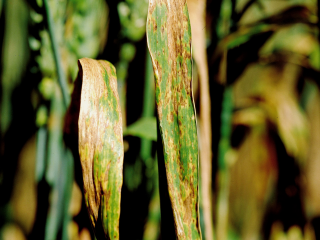Nodorum blotch in wheat
- Moora
- Yathroo
- Gillingarra
Agworld users have reported finding nodorum blotch ranging from low to medium severity in wheat crops (variety unknown) near Moora, Yathroo and Gillingarra.
Symptoms of nodorum blotch are tan-brown oval or irregular shaped leaf blotches with narrow yellow margins. Tiny brown fruiting bodies can occasionally be seen in lesions. Blotches become grey as they enlarge. Lower leaves are affected on young plants.
Nodorum blotch occurs commonly throughout the Western Australian wheatbelt particularly in high rainfall areas and can reduce grain yield and grain quality.
It frequently occurs together with yellow spot and these two diseases are very hard to distinguish with the naked eye due to almost identical symptoms. Nodorum blotch has the capacity to reduce yield by up to 50% when disease development is continuous due to favourable conditions throughout the season. When disease development is only favourable for part of the season, either before or after flag leaf emergence, losses around 20-30% can occur.
Impacts from leaf spot diseases vary greatly from season to season and between locations, dependent on inoculum load and seasonal rainfall. They are particularly a problem in continuous wheat crops in stubble retention farming systems as these diseases are stubble borne.
To check your wheat variety’s susceptibility to blotches and spots refer to DPIRD’s 2020 WA Sowing Guide – Wheat.
For wheat after wheat, when there is high disease pressure prior to stem elongation, DPIRD research has shown it may be economic to apply fungicide at, or prior to, early stem elongation (Z31, first node) particularly in medium to high rainfall areas where the crop is struggling with a heavy disease burden. A second spray may be required at or after flag leaf emergence.
In rotation crops in medium-high rainfall zones, application of foliar fungicide to affected susceptible crops at or after flag leaf emergence has been shown to provide an economic benefit:
- in crops having good yield potential
- where there is evidence of increasing leaf spot intensity down the canopy
- when there are good prospects of finishing rains (approximately 80mm in the two months after flag leaf emergence).
It is important to optimise control of nodorum blotch on leaves to reduce risk of infection of heads (glume blotch). For more information on fungicides refer to the DPIRD's Registered foliar fungicides for cereals in Western Australia page.
Growers are reminded to manage fungicide applications carefully to minimise the risk of fungicide resistance.
For further information on identifying and managing these diseases refer to the department’s Diagnosing septoria nodorum of wheat and Managing yellow spot and septoria nodorum blotch in wheat pages.
For more information contact Plant pathologists Kithsiri Jayasena, Albany on +61 (0)8 9892 8477, Geoff Thomas, South Perth on +61 (0)8 9368 3262 or Andrea Hills, Esperance on +61 (0)8 9083 1144 or Ciara Beard, Geraldton on +61 (0)8 9956 8504.
Original article author: Geoff Thomas (DPIRD South Perth).
Article updated by: Ciara Beard (DPIRD Geraldton), Manisha Shankar (DPIRD South Perth) and Kithsiri Jayasena (DPIRD Albany).

